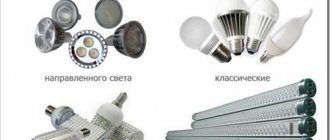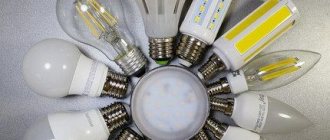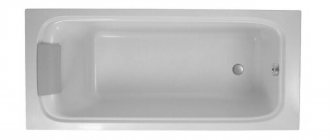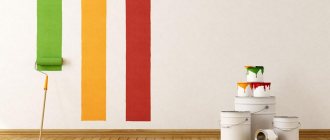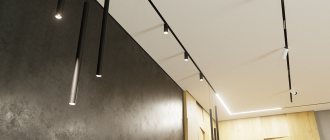«Which brand of LED lamps is better, better quality,
brightest"? This is a question we are often asked by our clients. Having scoured the Internet, we did not find an answer that would satisfy us completely, so we decided to do the experiment with the following conclusions ourselves. And this is what happened:
The test purchase of lamps in the name of truth took place in January 2015 at various retail outlets in Chelyabinsk and we now have 9 lamps for recessed luminaires from various manufacturers. All have approximately the same declared power of 5-6 W, warm color - 2700-3000 K. All lamps, except for one Gauss (we didn’t find the right one) type MR-16 - for recessed luminaires.
So. Our test subjects:
1. Lamp Gauss elementary E14 6 W 2700 K (1 year warranty). The photo shows a box from MR16 Elementary.
2. Estares GU10-9L-220V 5W warm (1 year warranty)
3. Elektrostandart JCDR AL 60SMD LED 5 W 3300K (1 year warranty) The packaging, unfortunately, has evaporated. Lost, basically.
4. Lamp Navigator NLL-MR16 5W 3000 K (2 year warranty)
5. Ecola MR16 5.4 W 2800K (1 year warranty)
6. Osram Decostar MR16 35W/12 V halogen, used as a standard
7. Pulsar MR16 ALM-JCDR 5W 2700K (2 year warranty)
8. Foton Fl-led MR16 6W 2700 K (the manufacturer was silent about the warranty)
9. Feron LB-26 7W 2700K (the manufacturer was silent about the warranty)
As we can see, all lamps, except one Gauss (we didn’t find the right one), are of the MR-16 or GU10 type - for recessed luminaires. The Gauss lamp is an E14 “candle,” but by removing the bulb, we got the sample we needed for our experiments.
Of course, there is a possibility that while this article is being written, some lamp model has been replaced with a more advanced and, possibly, higher quality one, but we repeat: all the lamps were purchased at the same time in popular retail outlets and not from a “hard-stock” sale. . Thus, it is possible with a high degree of probability to correctly characterize the manufacturer’s attitude towards its brand, and, given the price of the product, towards the buyer, ultimately.
Experiment 1. Determine the lamp with the best color rendering.
For convenience, we install all LED lamps in their native rim lamps at the same level with the LEDs strictly vertically upwards. For the purity of the experiment, i.e. To bring all lamps to equal conditions, we do the following: we cover the exposed LED board for Gauss, and for Osram and Estares, the reflectors with a translucent white plastic diffuser (trophy), thereby making the light as non-directional and diffuse as our other lamps.
We connect all the lamps at the same time. "Oil Painting" below. (Let's make a reservation: unfortunately, the photo did not convey the colors quite naturally, the way we saw them with our own eyes.)
We compared the glow of each lamp to the Osram reference halogen lamp, which has close to perfect color rendition (this is a well-founded point of view of science)
Based on what we saw with our eyes, we made our subjective assessment of the color rendering of each lamp, and you will have to believe it. We assigned the maximum number of points to the reference halogen - 5. All others - less, depending on the similarity of the glow with it and its pleasantness.
Conclusion from what we saw:
| Lamp brand | Gauss | Estares | Elektrostandart | Navigator | Ecola | Osram | Pulsar | Foton | Feron |
| Color temperature according to the passport, Kelvin | 2700 | just "warm" | 3300 | 3000 | 2800 | 3000 | 2700 | 2700 | 2700 |
| Glow quality assessment, points | 5 | 4 | 3 | 3 | 2 | 5 | 1 | 3 | 4 |
Gauss lamp glow
turned out to be the closest to the glow of the Osram MR16 lamp. Just the right amount of warmth, without pink or other unnecessary shades. The light from the Estares and Feron lamps turned out to be simply yellowish and pleasant. Looking ahead, we will say that this turned out to be the only plus of the Feron lamp. Whether you can use it will depend on how critically you take what is written next.
— Pulsar
and
Ecola
have worse color rendering. The red component in the spectrum is too intrusive. Pink light is not the most pleasant. The glow of the other lamps can be considered pleasant, despite the fact that it does not fit into the glow promised from the box of 2700 (like an incandescent lamp) or 3000K (12 Volt halogen, like our Osram) (only “Electrostandard” honestly wrote).
Disadvantages of an established brand
The disadvantages of Gauss products can only be judged by consumer reviews, since LED devices can really be put on the same level as such famous brands as Philips and Osram. The only drawback that immediately catches your eye is the relatively high cost.
The cost of a Gauss LED lamp with an E27 base and a power of 6 W is on average 85 rubles. A similar device of the Cosmos brand has a price of 60 rubles.
Sellers note high demand for products and a low percentage of replacement of defective products. By the way, the warranty for household models is 3 years. This time is usually enough to analyze the operation of the lamp and find out its shortcomings.
Experiment 2. The brightest LED lamp.
We prefer not to pay attention to what is written on the boxes. Manufacturers promise golden mountains of lumens (the amount of light in them is measured), it seems, based on the maximum light output of the type of exemplary quality LED used, multiplied by their quantity. But LEDs are different, good and bad, bright and so-so.
Let's see with our own eyes and the “eyes” of a special device that determines the level of illumination in the room. It's called a "lux meter". It is impossible for them to determine the luminous flux of a lamp, the so-called Lumens (Lm), the number that manufacturers deservedly and not very well write on the lamp packaging. This requires sophisticated laboratory equipment. We measured the illumination from each lamp with our lux meter. In all nine cases, naturally, at the same distance and position relative to the vertical axis of the lamp. Simply put, at the same point. And under the same night conditions.
Below are the illumination indicators, which is measured in lux (not to be confused with the luminous flux from the box!).
| Lamp brand | Gauss | Estares | Elektrostandart | Navigator | Ecola | Osram | Pulsar | Foton | Feron |
| Lamp power according to the passport | 6 W | 5 W | 5 W | 5 W | 5.4 W | 35 W | 5 W | 6 W | 7 W |
| The analogue of the halogen lamp promised by the box | 50 W | 50 W | no info | 35 W | 55 W | 35 W | 50 W | 35 W | no info |
| Illumination, Lux | 800 | 780 | 420 | 730 | 640 | 880 | 650 | 750 | 430 |
What we have here:
The brightest is our reference Osram halogen. The closest to her were Gauss, Estares, Photon and Navigator. Lamps of the Feron and Pulsar brands close the standings in this competition.
You can object with the words: “But the Gauss power is 6 W, of course it will be brighter.” Yes, Gauss is more powerful (according to the passport) initially. But is it really more powerful? More on this in the next experiment.
This experiment was done for the sake of one more conclusion - to check the honesty of the information indicated on the lamp packaging about its equivalent power to a halogen lamp. You yourself see the whole picture of the state of affairs - everyone lies, some lie more than others less. The tested LED lamps, without exception, did not even reach the brightness level of a 35 W halogen lamp, and there is no need to talk about the equality promised, for example, by the Pulsar with a 50 W halogen lamp.
Foton and Navigator were the most modest and lied the least. People's Choice Award for this.
An important point: the prize for brightness can be selected after a “doping test” in the following experiments. Don’t run to the store to buy the “best lamp”. Read to the end, let's draw conclusions together.
So we move on to the most interesting sections - with trepanation of lamps, with real measurements designed to determine the safety and durability of LED lamps.
Rating of the best manufacturers of LED light bulbs
| Nomination | place | Name of product | rating |
| The best manufacturers of LED light bulbs | 1 | Philips | 4.9 |
| 2 | Osram | 4.9 | |
| 3 | Gauss | 4.8 | |
| 4 | Feron | 4.7 | |
| 5 | Camelion | 4.6 | |
| 6 | A.S.D. | 4.5 | |
| 7 | Navigator | 4.5 | |
| 8 | Jazzway | 4.4 | |
| 9 | Era | 4.4 | |
| 10 | Space | 4.3 | |
| The best manufacturers of LED smart light bulbs | 1 | Xiaomi | 4.9 |
| 2 | Redmond | 4.8 |
Experience 3. Safety of LED lamps regarding electric shock to humans.
We open all the lamps, taking out, somewhere carefully, and somewhere mercilessly breaking out (in the name of science we will break even the wrong ones) diffusers and reflectors (Estares), getting to the LED boards and guts, called by some drivers, by others power supplies, and some even transformers. Let’s not quarrel between them, let’s just call the electronic giblets “BP”.
Once said and done, we see:
Hmmm..... Feron
and
Electrostandart
, this is unforgivable!
According to the requirements of our Russian safety regulations, the aluminum conductive body of these lamps requires special reinforced (double) insulation of the power supply and supply wires (electronic “guts”, for those who have forgotten). The wires and power supply (from Feron) do not have such insulation. In case of poor-quality soldering, crooked assembly, vibration, etc., a wire that comes off the board, a power supply element, ends up on the aluminum lamp body. The lamp is inserted into a steel (conducting current) lamp, which in 99% of cases (are your lamps real Italian!?) does not provide protective grounding.
Further events, no matter how they unfold, the result will be the same - “fuck you”!
Question to the brand owners: WHY? How they let something like this go on sale, how the certificates were made, is clear to everyone - in Russia so far only school teachers are imprisoned for bribes.
Feron 's Russian managers
and
Electrostandard
do not know Russian rules. And in China there are too many people, there are probably no life safety rules, traffic rules and mandatory fluorography and, in principle: “don’t feel sorry for anyone, no one...” . Further on in the course of the experiment, these two brands will be considered by us simply as “extras”. They no longer participate in the competition for the title of “best lamp”.
All other brands have a plastic non-conductive housing, or a part of it in which the power supply is hidden, and the LEDs are covered with an insulating plastic diffuser. It is safe.
About the Gauss brand and the Warton company
To make it easier to understand where the Gauss brand came from on the Russian market, you need to get acquainted with history. This is a fairly young enterprise, founded in 2009 and by 2022, it had managed to master two main areas - its own production of LED lamps and the sale of high-end Chinese products.
It all started with the distribution of Chinese lines of lamps, first fluorescent, and then (since 2010) LED. They enter the Russian market under the Gauss brand.
The name arose for a reason. LED lamps are named after the great mathematician Gauss, who made his discoveries at the turn of the 18th and 19th centuries. Among other things, he studied the power of light from natural sources and the possibility of converting energy into light.
Today the Warton company is known in Russia and abroad. She actively participates in international exhibitions, demonstrating achievements in the field of lighting technologies
In addition to selling Chinese LED products, the company produced its own lamps. The production is located in the Tula region, in the small town of Bogoroditsk. On the site where an abandoned factory was previously located, a complex of modernized workshops equipped with new lines and machines appeared.
The Warton brand produces high-quality lamps for industrial, educational, public and administrative buildings.
But the average user is closer to Gauss products - LED lamps for home use. Most of them are equipped with a base - for chandeliers and lamps, but some series are created specifically for spot lighting
Why did the company's owners rely on LED products, since they started with fluorescent products? Wise and enterprising managers realized in time that the time was coming for more economical, safe and less expensive products.
In addition, in 2009, the federal law “On Energy Saving” was adopted, regulating the economical consumption of electricity and its efficient use in state-owned enterprises.
Experiment 4. The impact of LED lamps on the organs of vision and general well-being of a person.
British scientists have found that factors such as illumination level, color rendering, color temperature and light pulsation greatly influence our performance, emotional state and, as a result, well-being in general through the eyes.
The brighter or whiter the light does not mean it is better. Each lamp has its own purpose, place and time. But with the pulsation of light everything is simple. The more noticeable it is, the worse it is for our eyes and, therefore, for us in general. Ripple is the blinking of light, clearly noticeable by the eye on “soviet” fluorescent lamps in our offices and government agencies. And also in the entrance lamp, where 10 years ago your dad installed a diode so that Ilyich’s lamp did not burn out.
But the examples above are for you to understand that there is pulsation. In the vast majority of cases, even closely observing the lamp in the lamp, we do not notice this vibration of light. Nevertheless, it is there.
Modern requirements of GOSTs and SNiPs regulate this very pulsation for non-residential premises, without going into your personal life at home. We will not go into details and we will simply say in numbers and formulas: in an LED lamp there is always a pulsation of light. BUT: depending on the type of PD, from uncomfortable, dangerous to absolutely miserable, safe. The more complex the power supply circuit, the more elements it contains, the less this ripple and, accordingly, the safer the lamp is for the eyes. If you type on a computer, read, sew, cross-knit, or weave nets, e.g. your work requires close visual attention - your lamp must be equipped with lamps with modern “correct” power supplies. For all other “pass-through” rooms there are no strict requirements for light pulsation, and therefore for the power supply circuit.
So how can you identify a dangerous “pulsating” block from a safe one? Look at the photos of the power supply of our experimental lamps.
A safe circuit has a yellow cube in its design - a choke or a transformer (the latter looks the same). Both of these make us understand that this circuit supplies the LEDs with a very high frequency current. So high that the device, much less the eyes, skin, nose, etc., does not detect the pulsation (blinking) of light.
Lamps Gauss, Estares, Navigator, Electrostandart
and
Ecola
have this choke or transformer. There are essentially no pulsations. There won't be a nervous breakdown
There are essentially no pulsations. There won't be a nervous breakdown
Lamps with such circuits should properly have an inscription on the box that says something like “pulsation coefficient” or simply “pulsation” less than 5%” (the threshold from which the lamp begins to be considered dangerous to the eyes) or even simpler “without pulsation.” But since there are no regulations on pulsation for residential premises, such an inscription on the packaging of our lamps is completely optional, and those manufacturers (of our experimental ones only Gauss) who apply it do so only in order to increase sales to those who know about This.
Lamps Feron, Foton, Pulsar
They work using a cheap circuit for powering LEDs with rectified voltage. This scheme is not bad because it is cheap. And, of course, the price of these lamps should be cheaper than others. But these lamps should be used exclusively in “pass-through” rooms - corridors, bathrooms, dressing rooms, etc.
PS For those who are “in the know”.
At the Foton
The filter capacitor capacity is the smallest - 1 mF. All others have 3-4 mF.
Helpful advice:
For the majority who are not going to open the lamps to look for “yellow cubes” there, but are concerned about the safety of their family’s health, we can offer this option: take a camera (digital, of course) and look through the viewfinder at the lamp in focus mode. If you see “flashes” of light, the pulsation is significant.
Advantages and disadvantages of Era products
Judging in general terms, the company is a reliable and experienced supplier whose product quality is as close as possible to European standards. She often received awards and became a laureate of various design competitions.
The manufacturer tries to produce products for people. Therefore, the product is distinguished not only by its quality, but also by its aesthetics. Many models can rightfully be called a work of technological art
Among the many advantages of the company, the presence of its own engineering center should be especially highlighted.
Thanks to this, the range is regularly updated with new, truly unique models of lighting equipment. The manufacturer can guarantee that its products are completely safe for the consumer.
Many modifications of lamps are equipped with an automated control system. This addition makes it possible to set the color mode, select the glow temperature, and the radiation level.
It is also worth adding cost-effectiveness to the above features - in addition to the fact that their operation requires a minimal amount of electricity, they also cost adequate money. Therefore, a consumer with any income level will be able to afford such a purchase.
There is only one drawback - weak fasteners. But this problem can be solved quite easily by using additional parts.
Experience 5. Reliability, service life of LED lamps.
Low energy consumption, reliability and, most importantly, a huge service life - this is what we count on when we buy an LED lamp and pay many times more for it than for a regular Ilyich lamp. It would be a great shame to be disappointed after just half a year, as often happens with energy-saving spiral-type lamps.
The reliability of LED lamps, and, in principle, all LED lamps, depends on the following conditions:
— the quality of the LEDs themselves, their soldering;
— thoughtfulness of the circuit, quality of electronic components and assembly of the power supply;
— competent design of the lamp housing, providing the required heat dissipation from the LED panel;
— external factors: the quality of the voltage in the network, the temperature conditions in which the lamp is operated (literally: so that it does not stand in a bathhouse or bake in the sun during operation).
Failure to comply with at least one of these conditions leads to premature failure of the lamp. A lamp may have amazingly efficient LEDs, but what's the point if... well, you get the idea, anyway.
We also tried to check our experimental lamps by one more parameter: “overloading” the LEDs with ultra-high currents. An LED can be made to glow brighter by applying more current to it than it is designed for. But it was not possible to draw a full conclusion. Data sheets for the type of LEDs used are not included. It's a pity! This was very helpful.
We also cannot say anything about the quality of the LEDs themselves in all lamps; we do not have microscopes. It is possible that different brands of lamps have the same type of LED (5630 for example), but one manufacturer buys a high-quality and expensive LED, while the other buys a cheap and bullshit one. But they look the same.
Go ahead.
We can assume that Feron and Electrostandard use obsolete 3528 LEDs with low light output. All other brands of lamps have switched to the new type of LEDs 2835 and 5630. LEDs of this type require fewer quantities, and correspondingly fewer solder connections, and any connection is a “weak point” with loss of “signal” - voltage and power (you overpay for this , look above at the brightness of these lamps). Gauss, Estares and Pulsar lamps have the smallest number of LEDs, and accordingly the reliability of the board itself with diodes is higher.
Online store of LED lamps are essentially of two types: without the yellow choke cube (transformer) and with it. The first option is much simpler, clearer and cheaper. Perhaps even more reliable than the second one, given the fact that the quality of the electronic components used is unclear.
However, we live in the 21st century. The time of gram records and spinning is in the past. The option with a pulsed high-frequency LED power circuit (the second option with a yellow choke) is better, because this principle ensures a stable required current through the LEDs, even if the network voltage changes or is higher than the nominal 220-240 V. This is very important to prevent the diode from overheating due to increased current flowing through it.
The lamp body, as mentioned above, is also a factor affecting the life of the lamp. The design of the case should be designed taking into account the ability to effectively dissipate the heat generated by the LEDs, and it is very decent. Why remove heat? Then, the lower the temperature of the LED, the longer it shines just as brightly.
There is another important point related to the temperature inside the lamp housing: the electronic components of the lamp power supply also cannot withstand high temperatures.
Thus, the faster the lamp body heats up on the outside, the better for it. This means that heat is dissipated well. After all, a good, working thermos is always cold on the outside, as it accumulates heat and does not allow it to escape.
Our lamps have the following types of housings.
- Aluminum. (Feron and Electrostandard lamps). Everything would be fine if it were not for the danger of being killed by such a lamp. Fail.
— Single-layer plastic. (Photon lamp). Heat removal is very difficult. The service life of the power supply is the shortest, the degradation of LEDs (a drop in their brightness over time) is the fastest. Rating "ud".
— Two-layer plastic, internally reinforced with aluminum (Gauss and Navigator lamps). The temperature inside such a case is evenly distributed over its surface and removed from it, albeit through plastic. They will work out the period required by the guarantee, but they will not give you eternal life. From a marketing point of view, this is the most profitable option for the seller. And people won’t throw tomatoes at you and leave you without work; they’ll come for a new lamp in two years. Rated "choir".
— The most expensive option, but also the best, because it provides the least heating of LEDs and power supply parts for Estares, Ecola and Pulsar lamps. The LED board is housed inside an aluminum heatsink for excellent heat dissipation. This principle is used to make LED lamps from the best manufacturers - Philips and Osram, for example. Rating "excellent"
It is worth noting that Gauss also has a more expensive series of lamps - Professional, made using the same technology.
Positive and negative customer reviews
Gauss is a brand about which there are much more positive reviews than negative ones. According to statistics, unpleasant characteristics indicated by buyers can be found in approximately 10 cases out of 100.
The advantages of the brand include the following qualities:
- saving energy is the main reason why people choose LED products;
- modern design - lamps are often a visible element of the lamp, so their external design is also important;
- no heating – it has been verified that the LEDs minimally heat the lamp body and do not deform adjacent materials;
- absence of blinking and pulsation - this is good for the eyes, does not distract or interfere with work;
- instantaneous achievement of maximum brightness - unlike, say, energy-saving lamps, which become bright gradually.
Business buyers keep receipts, packaging and a warranty card so that in the event of a breakdown within the next 3 years they can replace the lamp with a new one.
You actually have to replace a spotlight or a lamp with a traditional base less often. Alternative versions of other brands burn out faster, like other types of lamps - for example, halogen
They also note the convenient, informative packaging. The paper box containing the purchase contains all the main characteristics of the device, making it easier to select an LED light bulb. Other manufacturers often deliberately remain silent about certain properties of their products.
Brand claims are quite subjective. For example, many people don’t like “cold” light - but Gauss always has the same model with a yellow tint in its arsenal. Some models, due to their design, have a relatively short service life - up to 25 thousand hours.
Many people don’t like the large selection of lamps – it’s difficult to settle on one specific one. But most often complaints relate to cost, although the brand is more likely to belong to the middle price segment.
I would like to separately note that the cost of the final product is influenced by the total cost of high-quality components - hence the seemingly inflated price. However, the lamps work for a long time, at full power and really save energy, so the price is justified and the costs quickly pay off.
The following article will introduce you to choosing a dimmer for an LED device, in which this interesting issue is discussed in the smallest detail.

